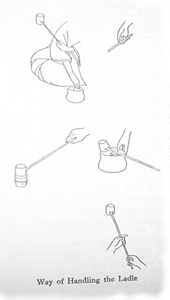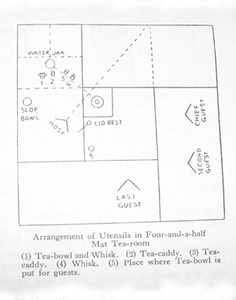THE KAKEMONO
掛け物
The writings of great Zen priests are preferred to all others in the Tea-room since they suggest the feeling of drinking tea with reverence in the presence of these sages.
禅僧の墨跡は茶室において大変喜ばれます。それは、茶を飲むときにその書の教えに対し尊敬を込めてその言葉とともに頂くからです。
 Next comes old Japanese poetry such that of Teika-Kyo, Shunzei, Tsurayuki or Saigyo.
Next comes old Japanese poetry such that of Teika-Kyo, Shunzei, Tsurayuki or Saigyo.
続いて使われるのはTeika-Kyo、Shunzei、Tsurayuki や Saigyo達歌人の歌が書かれたものです。
Calligraphs (Bokuseki) either old or new are equally suitable, and good modern ones or the writings of one's friends are preferable to some spurious antique.
墨蹟は新旧を問わずふさわしいもので、新しいものや写しものでも、その過去の作品に準拠していれば使われます。
Then come old painting.
そして、古い絵が使われます。
They should have little or no color and are best if they took faded and indistinct.
それらは、大きくなく色紙ではいけません、古く時代が付いたものが最良です。
Black and white landscapes of a rough type of the Nangwa school are very pleasant and modern specimens will do if old are not available.
Nangwa Schooの白と黒で書かれた粗野な風景画などはとても喜ばれます。そして、新しい物もそれが古くなければ許容されます。
Figure subject and brightly colored birds and flowers are of course out of place in the Tea-room.
物体や綺麗な鳥や花はもちろん茶室ではいけません。
The Haiku of Basho are quite suitable, but this does not apply to other poets of this school who lack the necessary flavor of " Sabi."
芭蕉の俳句なども使われますが、寂の風がないようなものはいけません。
Poems that treat of love or sentiment are quite inadmissible, however ancient they may be, though "Waka" that describe the seasons or have merely an esthetic appeal may be hung.
愛や感情を表した歌は敬遠されます、古い和歌などは良いですが、とにかく、四季を感じさせるものは軸に掛けられます。
Similarly didactic sentiments such as those taken from the texts of Confucianism are incompatible with the spirit of Tea, for besides being concerned with everyday affairs they have a minatory air and smack of conscious pedagoguery and so hardly conduce to calmness of mind.
孔子の教えからとったような教訓めいたものは、茶の湯の精神とは両立が難しいために使われません。が、日常の修行という意味において同じ意味合いがあります。ただ、学者ぶった顕示の態度や精神の安定を押し付けがましく言うことは避けられるのです。
Both writing and painting should be naiv and unsophisticated rather than a display of finished technique, and it is the preeminence of the Zen priests in this quality that makes their writings so desirable.
墨蹟や絵は技術的なものではなく素朴なものでなければなりません。優秀な禅僧の書いたものが望ましいのです。
With regard to the Kakemono, if it is a writing may be used at any time that suit its sentiment, but if it is a painting summer scenes con only be hung in winter and winter ones in summer.
掛け物に関して、精神的なものであればいつでも使われますが、例えば夏の季節感がある絵などは冬に掛けられ、逆に冬の季節であれば夏に使われます。
 The writing considered most valuable, as it is one of the oldest, is the famous letter of Tokko Zenji of the Ikuozan or Asoka Temple in Cha-kiang, written to Taira Shigemori to acknowledge the receipt of a hundred ryo of gold which he had sent to that monastery in the twelfth century, and so called the "Kane-watashi no Bokuseki" or "Writing of the handing over of the money."
The writing considered most valuable, as it is one of the oldest, is the famous letter of Tokko Zenji of the Ikuozan or Asoka Temple in Cha-kiang, written to Taira Shigemori to acknowledge the receipt of a hundred ryo of gold which he had sent to that monastery in the twelfth century, and so called the "Kane-watashi no Bokuseki" or "Writing of the handing over of the money."
墨蹟でもっとも価値があるのは、一番の古物、IkuozanのTokko Zenjiの手紙だと思います。十二世紀に、平重森が彼の寺に金を贈り、その礼の手紙であります。この墨蹟のことを「金わたしの墨蹟」と言います。
It is in the possession of Prince Tokugawa Iesato who also owns another great treasure of the kind, the autograph of Engo Zenji, the compiler of the Hekigan Roku which Takahashi calls the "Zen Bible."
同様にTokugawa Iesatoが所有するEngo Zenji署名の掛け物があります。高橋氏が「禅の聖書」と呼んでいるものです。
It is hardly proper for Zen to have a bible, but even these sages are not quite consistent in their contempt of scriptures, and it may be this that makes their bible and its compiler interesting.
これはとても興味深いものなのでですが、聖典とは言え、彼らの教えとは若干のひらきがあるものなのです。
Moreover it is quite unintelligible.
くわえて、これは知的なものではありません。
Other eminent Zen monks whose writings are favored are Eisai, Dogen, Daito, Muso, Nambo, Ikkyu, Kokei, Takuan, Kogetsu, etc.
他の有名な僧として、Eisai、Dogen、Daito、Muso、Nambo、Ikkyu、Kokei、Takuan、Kogetsuなどがいます。
INTRODUCTION-1 TITLE CONTENTS